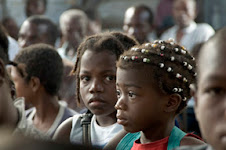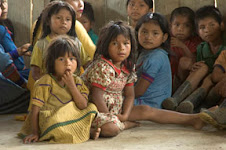(la versión en castellano se encuentra debajo...)
Saturday, July 28, 2007
The travel from Cleveland to Bogotá was long, with a few misadventures—the flight from Cleveland to Newark was delayed, producing some anxiety for me about making the connection to Bogotá. But in the end there was no problem there.
But as the plane for Bogotá pulled back from the terminal, the tip of the wing brushed against another plane! No damage to our plane that required any action, but it took an hour and a half to determine that! I wondered if this was a bad omen, but of course I really don’t believe in that…
In fact, today I managed to reach more than half the people I was calling, which was unusually good. After a productive trip to a book distributor here that specializes in art, architecture and photography books, I was able to return home with most of what I wanted—much better luck than when I had contacted the publisher in Barcelona…
And then, I was in an unusual situation—I had the entire afternoon and evening to myself in Bogotá. Usually I’m here either on the way to El Chocó or on the way back to the States. So I decided to do what various people have recommended, and I went (via the Transmilenio bus system, which I’ve used on each visit here) to visit the Museum of Gold (more properly, the Museum of Gold of the Bank of the Republic).
There, I was a real tourist, like the rest of the folks—Colombians (whites, mestizos, indigenous), but also Germans, Greeks, Italians. Really, except for the airport, I think these are the first foreign tourists I’ve ever seen here. I even bought postcards to send to folks at home—the first time I’ve ever bought (or even seen) postcards in Colombia. All of this, of course, shows more than anything how limited my range of experiences has been.
I liked the museum—lots of beautiful stuff. Interestingly, it’s more than anything a museum of archeology—the gold, ceramic and copper pieces are presented as illustrations of aspects of social life in a variety of ancient and historic indigenous cultures. I liked it, but I thought there was something enormous that was entirely left out—gold mining (not exactly a trivial topic). Nothing about mining practices (though there were interesting comments about burial practices), nothing about the social, cultural, economic, environmental impacts of gold mining and commerce. Hmm…
When I left the museum, I went on a hunt for stamps—I never found any! There was one big post office building several blocks away, but it has been abandoned. A series of people directed me to stationery stores, travel agencies, etc., etc., but no luck.
As always, I enjoyed just walking through the streets—the plazas were filled with people, mostly families. In one, little kids were getting rides, and having their pictures taken, but not on the ponies we might expect at home, but on…llamas. This was right near the ladies who were selling corn to feed the pigeons!
There’s also some emphasis on books here now, and I spent a good deal of time examining booksellers’ stalls in some of the plazas, and just poking around.
The house where I’m staying is in Chapinero bajo, an area that has had its days of glory, but they are long gone. One of the young guys who live here told me that right near the house is a “tolerance zone,” where prostitution and other illegal or questionable “vices” are tolerated by the authorities. This was confirmed by the men (and women) on the corners of the main avenue here handing out little ads for the “clubs”.
Finally, I was reminded that politics—broadly understood--is a complex and lively arena in Colombia. I passed a group of people who were taking down an exhibit about violent repression as a memorial to the great Colombian popular leader, Jorge Eliécer Gaitán, which they had erected on the very spot where he had been assassinated in April of 1948. I spoke with the folks working there, who said that this was the end of several days of activities in support of victims of repression throughout the country.
And then, near my own neighborhood, I saw a poster put up by the Municipal Government of Bogotá calling for a “humanitarian accord.” This is a call for an agreement between the national government and guerrilla groups to win freedom for people kidnapped by the guerrillas. Human-rights organizations and popular groups have been pressing for this as an alternative to the announced intention of the Uribe government to free the hostages through military force, which these groups believe will result in the deaths of hostages. It was good to end the day seeing this poster on behalf of the municipal government..
Sábado, 28 de Julio, 2007
El viaje desde Cleveland a Bogotá fue largo, con unos contratiempos—el vuelo de Cleveland a Newark se atrasó, el cual me produjo unas ansias en cuanto a la conexión al vuela para Bogotá. Pero al fin no hubo problema con esto.
Pero en el momento que el avión para Bogota se alejaba de la Terminal, ¡la punta del ala rozó otro avión! No hubo daño a nuestro avión que necesitara acción alguna, pero ¡demoraron hora y media para determinar eso! Me preguntaba si era mal augurio, pero desde ya no creo en eso…
De hecho, hoy logré lanzar meas que la mitad de las personas que traté de llamar, que fue muy bueno. Después de una visita fructífera a una distribuidora de libros que especializa en el arte, la arquitectura, y la fotografía, logré volver a casa con la mayoría de lo que buscaba—suerte mucho mejor que había tenido al intentar comunicarme con la casa editorial en Barcelona…
Y luego, me encontré en una situación poca normal—tuve toda la tarde y noche libre en Bogotá. Normalmente, estoy acá de paso: o viajando para El Chocó o volviendo a Estados Unidos. Pues, decidí hacer lo que me había recomendado varias personas, y fui (en el sistema de buses Transmilenio, que he ocupado en cada visita acá) a visitar el Museo del Oro (meas correctamente, el Museo del Oro del Banco de la República).
Allí, era yo turista de verdad, como la deseas gente—colombianos (blancos, mestizos, indígenas), pero también alemanes, griegos, italianos. De hecho, salvo en el aeropuerto, creo que ess son los primeros turista que jamás he visto acá. Incluso, compré tarjetas postales para mandarlas a la gente—primera vez que he comprado (o visto) postales en Colombia. Todo eso, por supuesto, antes de nada demuestra que tan limitado ha sido el rango de mis experiencias.
Me cayó bien el museo—muchas cosas bellas. Interesante, a mi me parece más que nada museo de arqueología—las piezas de oro, cerámica y cobre se presentan como ilustraciones de aspectos de la vida social en una variedad de culturas indígenas antiguas e históricas. Me cayó bien, pero creo que falta algo enorme que es totalmente ignorado—la minería del oro (que no es tema trivial). No hay nada sobre las prácticas mineras (aunque sí hay comentos interesantes sobre prácticas funerarias), nada sobre los impactos sociales, culturales, económicos, ambientales de la minería y el comercio del oro. Curioso…
Cuando salí del museo, entré en búsqueda de estampillas—jamás las encontré. Hubo un edificio del correo a unas cuadras, pero ha sido abandonado, Una serie de personas me dirigieron a papelerías, agencias de viajes, etc., etc., pero sin resultado.
Como siempre, me gustó el simple caminar por las calles—las plazas estuvieron llenas de gente, mayormente familias. En una, a l@s niñit@s, l@s estaban montando para que l@s llevasen y para sacarles fotos, pero ¡no en caballitos, sino en llamas! Esto fue cerquito a las señoras que vendían maíz para alimentar las palomas.
En este momento, hay un énfasis en el libro acá, y me entretuve mirando los puestos de unos vendedores de libros en una plazas, y nada más vacilando…
La casa donde me estoy quedando está en Chapinero bajo, una zona que ha tenido sus días de gloria, pero hace bastante. Uno de los jóvenes que viven acá me contó que muy cerca de la casa hay una “zona de tolerancia,” donde la prostitución y otros ‘vicios” ilegales o dudosos son tolerados por las autoridades. Eso fue confirmado por los hombres y mujeres) en las esquinas de la avenida principal acá que reparten hojitas de publicidad para los “clubes”.
Finalmente, unas cosa me recordaron que la política—entendida en sentido amplia—es un campo complejo y vivo en Colombia. Pasé un grupo de personas que desarmaban una muestra sobre la represión violenta como memoria al gran líder popular colombiano, Jorge Eliécer Gaitán, que habían puesto justo en el lugar donde fue asesinado en Abril del 1948. Hablé con la gente allá, que me dijo que fue el final de unos días de actividades en apoyo a las víctimas de represión de todo el país.
Y luego, cerca mi barrio, vi un cartel montado por la Alcaldía General de Bogotá, pidiendo un “acuerdo humanitario.” Este en una llamada por un acuerdo entre el gobierno nacional y las guerrillas, para poner a libertad gente secuestrada por los guerrilleros. Las organizaciones defensoras de derechos humanos y grupos populares han venido abogando por esto como alternativa al plan anunciado por el gobierno de Uribe de liberar los rehenes por fuerza militar, que aquellos grupos creen tendrá por resultado la muerte de rehenes. Ver este cartel de parte de la Alcaldía fue buena manera de terminar el día.




